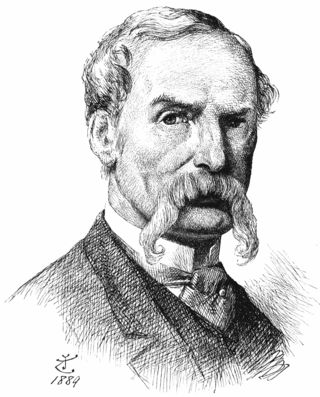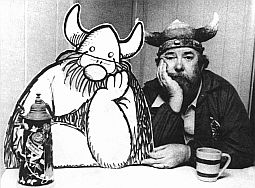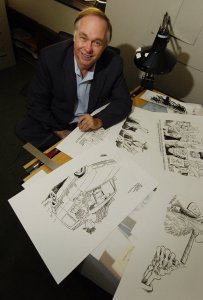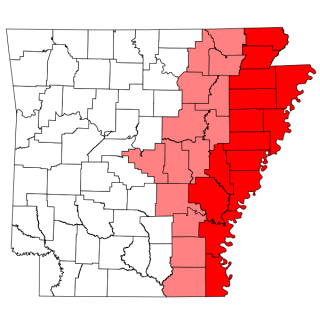
Sir John Tenniel was an English illustrator, graphic humourist and political cartoonist prominent in the second half of the 19th century. An alumnus of the Royal Academy of Arts in London, he was knighted for artistic achievements in 1893, the first such honour ever bestowed on an illustrator or cartoonist.

Pine Bluff is the tenth-most populous city in the US state of Arkansas and the county seat of Jefferson County. It is the principal city of the Pine Bluff Metropolitan Statistical Area and part of the Little Rock-North Little Rock-Pine Bluff Combined Statistical Area. The population of the city was 41,253 in the 2020 census.

Richard Arthur Allan Browne was an American cartoonist, best known for writing and drawing Hägar the Horrible and Hi and Lois.

Frank McKinney Hubbard, better known as Kin Hubbard, was an American cartoonist, humorist, and journalist. His most famous work was for "Abe Martin". Introduced in The Indianapolis News in December 1904, the cartoon appeared six days a week on the back page of the News for twenty-six years. The Abe Martin cartoons went into national print syndication in 1910, eventually appearing in some two hundred U.S. newspapers. Hubbard also originated and illustrated a once-a-week humor essay for the "Short Furrows" column in the Sunday edition of the News that went into syndication in 1911. The self-taught artist and writer made more than eight thousand drawings for the Indianapolis News and wrote and illustrated about a thousand essays for the "Short Furrows" column. His first published book was Collection of Indiana Lawmaker and Lobbyists (1903), followed by an annual series of Abe Martin-related books between 1906 and 1930, as well as other works such as Short Furrows (1912) and Book of Indiana (1929). Humorist Will Rogers once declared that Hubbard was "America's greatest humorist".

Douglas Nigel Marlette was a Pulitzer Prize-winning American editorial cartoonist who, at the time of his death, had also published two novels and was "finding his voice in writing long-length fiction." His popular comic strip Kudzu, distributed by Tribune Media Services from 1981 to 2007, was adapted into a musical comedy.
Frank O'Neal was an American cartoonist best known for his comic strip Short Ribs, which he wrote and drew from 1958 to 1973.

Freeman Harrison Owens was an early American filmmaker and aerial photographer.
Gary Varvel is an American editorial cartoonist. Varvel was the editorial cartoonist for Indianapolis Star from 1994 to 2019. He was the chief artist for The Indianapolis News for 16 years. His works are syndicated with Creators Syndicate.

Charles Harris Kuhn, nicknamed Doc Kuhn, was a cartoonist best known as the creator of the comic strip Grandma. He usually signed his drawings and comic strips Chas. Kuhn.

John Tinney McCutcheon was an American newspaper political cartoonist, war correspondent, combat artist, and author who won a Pulitzer Prize for his 1931 editorial cartoon, "A Wise Economist Asks a Question," and became known even before his death as the "Dean of American Cartoonists." The Purdue University graduate moved to Chicago, Illinois, in 1890 to work as an artist and occasional writer for the Chicago Morning News. His first front-page cartoon appeared in 1895 and his first published political cartoon was published during the U. S. presidential campaign of 1896. McCutcheon introduced human interest themes to newspaper cartoons in 1902 and joined the staff of the Chicago Tribune in 1903, remaining there until his retirement in 1946. McCutcheon's cartoons appeared on the front page of the Tribune for forty years.

The Arkansas Delta is one of the six natural regions of the state of Arkansas. Willard B. Gatewood Jr., author of The Arkansas Delta: Land of Paradox, says that rich cotton lands of the Arkansas Delta make that area "The Deepest of the Deep South."

Clifford Kennedy Berryman was a Pulitzer Prize–winning cartoonist with The Washington Star newspaper from 1907 to 1949. He was previously a cartoonist for The Washington Post from 1891 to 1907.

The Plaquemine culture was an archaeological culture centered on the Lower Mississippi River valley. It had a deep history in the area stretching back through the earlier Coles Creek and Troyville cultures to the Marksville culture. The Natchez and related Taensa peoples were their historic period descendants. The type site for the culture is the Medora site in Louisiana; while other examples include the Anna, Emerald, Holly Bluff, and Winterville sites in Mississippi.

Gaar Campbell Williams was a prominent American cartoonist who worked for the Indianapolis News and the Chicago Tribune. His scenes of horse-and-buggy days in small towns of the Victorian era included situations taken from memories of his childhood in his hometown of Richmond, Indiana. Labeled the "Hoosier Cartoonist" or the "James Whitcomb Riley of the Pencil", his cartoon panels captured the flavor of a bygone era to the degree they were deemed worthy of reprinting in the mid-20th century years after his death.

Larry Dell Alexander is an American artist, Christian author and Catechist from Dermott, Arkansas, in Chicot County. Alexander is best known for his creations of elaborate colorful, and black & white "pen and ink" drawings in his "crosshatching", or "hatching" technique, and his acrylic paintings. His works not only depict the African-American experience but also the experiences of people throughout American history itself. He also received notoriety and a personal presidential thanks for his personal rendition of a "Clinton Family Portrait" oil painting which he gave to U.S. President Bill Clinton in 1995. It is now a part of the collection at the Clinton Presidential Library in Little Rock, Arkansas. He is also known for the Arkansas Schools Tours that he did between 1996 and 2006. He has written several bible commentary books on the Christian Bible and in recent years he is better known for his writings and teachings on Christianity

The Indianapolis Freeman (1884–1926) was the first illustrated black newspaper in the United States. Founder and owner Louis Howland, who was soon replaced by Edward Elder Cooper, published its first print edition on November 20, 1884.
Barbara Brandon-Croft is an American cartoonist, best known for creating the comic strip Where I'm Coming From, and for being the first nationally syndicated African-American female cartoonist.

Joseph Carter Corbin was a journalist and educator in the United States. Before the abolition of slavery, he was a journalist, teacher, and conductor on the Underground Railroad in Ohio and Kentucky. After the American Civil War, he moved to Arkansas where he served as superintendent of public schools from 1873 to 1874. He founded the predecessor of University of Arkansas at Pine Bluff and was its first principal from 1875 until 1902. He ended his career in education spending a decade as principal of Merrill High School in Pine Bluff. He also taught in Missouri.

Quigualtam or Quilgualtanqui was a powerful Native American Plaquemine culture polity encountered in 1542–1543 by the Hernando de Soto expedition. The capital of the polity and its chieftain also bore the same name; although neither the chief nor his settlements were ever visited in person by the expedition. Their encounters consisted of messages sent by runners and a three-day long canoe battle on the Mississippi River. Multiple archaeological cultures, archaeological sites, and protohistoric and early historic period Native American groups have been proposed by historians and archaeologists to identify the polity, but their identity will probably never be known with any degree of certainty. The chroniclers of the DeSoto expedition said the chiefdoms near the Mississippi River, especially Guigualtam, were the best they encountered during their three-year journey through the southeastern United States.

Benjamin Frank Adair was a lawyer who served in the Arkansas Legislature in 1891 representing Pulaski County.






















